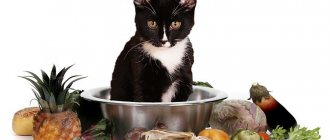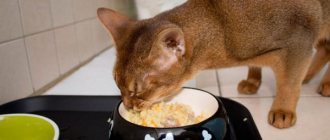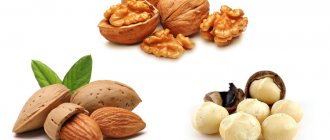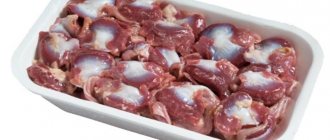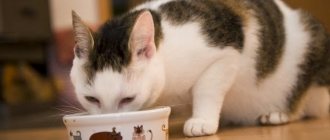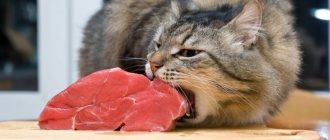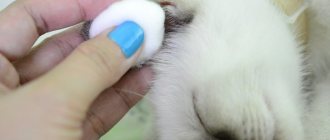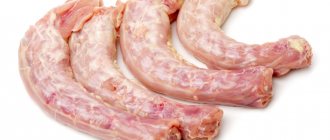An unbalanced diet contributes to the development of various diseases in domestic cats. In order for your pet to live a long and happy life in your family, without experiencing any special health problems, create the right menu for him from healthy foods and be sure to include different types of cereals in your cat’s diet. In our article we will talk about what cereals can be given to cats and what is best to exclude from your furry pet’s diet.
Cereals contain a whole list of useful microelements that have a beneficial effect on the functioning of the digestive tract and the entire body as a whole. This product is served boiled without salt and spices. For appetite, you can mix the finished porridge with other products from the daily diet of your domestic cat. Well, now about everything in more detail!
Acceptable cereals for cats
Cats can be fed easily digestible cereals made from different types of cereals. According to the recommendation of experienced veterinarians, the following should be added to the animal’s diet:
- Rice porridge made from unpolished cereals containing a large number of useful microelements. Rice improves the digestion process and promotes good bowel movements. You can boil cereals in meat or fish broth without salt and spices. For a taste effect, rice is diluted with pieces of lean meat or fish without bones.
- Buckwheat porridge is an equally healthy product in the diet of a domestic cat. This cereal contains a large amount of proteins, carbohydrates, calcium and fiber. All these microelements are synthesized into energy, giving strength and vigor. Calcium promotes the proper formation of bone structure, which is especially important for the proper growth and development of small kittens. Buckwheat porridge can also be seasoned with pieces of meat and a little vegetable oil added for taste.
- Oatmeal and rolled oats are a real storehouse of useful vitamins that prevent the development of skin diseases. This product contains biotin, magnesium, phosphorus, calcium, zinc, sodium, potassium and other beneficial substances. Oatmeal can be cooked in milk, without adding salt or sugar.
- Pearl porridge, rich in various vitamins, should also be present in the diet of a domestic cat. It contains beneficial amino acids that improve intestinal function and prevent the development of allergic reactions in the animal. Such cereals can be boiled in meat broth and served with pieces of boiled meat.
Rules for organizing wet food feeding
A good wet hypoallergenic cat food or dietary treat is not suitable for all pets, and when choosing such food it is important to consider the following factors:
- after opening a canned food or package, they cannot be stored for a long time;
- feeding with wet food must be combined with the correct drinking regime;
- Wet food is more expensive than dry food and the food supply should not exceed reasonable limits.
When purchasing food for future use, cat owners should understand that when the expiration date expires, all canned food will have to be thrown away.
Prohibited cereals for cats
The most popular baby porridge is semolina, which is absolutely useless for cats. It has practically no beneficial properties and is characterized by extremely rapid saturation, which can be completely unsafe for the cat’s body.
Semolina porridge can be given to a cat as an exception, but infrequently and in small quantities.
This type of cereal should absolutely not be fed to sterilized cats. Semolina is not suitable for neutered cats either. If you ignore the recommendations of veterinarians and feed your furry friend such useless food, there is a high probability of the animal developing urolithiasis and diabetes. There are also greater risks of obesity.
So, semolina is the most useless and even dangerous product for cats.
The category of prohibited products also includes corn porridge, which is no less useful for tailed representatives. It is poorly absorbed by the body of cats and can cause serious health problems in animals suffering from diseases of the digestive tract. In order not to tempt the fate of the animal, exclude corn porridge from your cat’s diet!
You should also not include pea porridge on your pet's menu. This product is not absorbed by the animal's body and causes constipation and flatulence.
Although wheat porridge contains a lot of useful microelements, it is still not recommended for feeding cats and kittens. Dishes made from this product are difficult to digest and often lead to bloating, flatulence, intestinal colic and dysbacteriosis. And besides, wheat porridge contains a lot of gluten and gluten, which is absolutely unnecessary for the cat’s body.
The list of prohibited cereals also includes barley porridge, which is poorly digestible and negatively affects the functioning of the gastrointestinal tract of animals. Once in a cat's body, the product causes severe fermentation, flatulence, bloating, spasmodic pain and constipation.
Regular consumption of barley porridge leads to the development of inflammatory processes in the intestines and other gastrointestinal diseases.
When not to give rice
Unfortunately, not every pet is in excellent health. Accordingly, each owner should make his own decision about which foods to include in the cat’s diet and which not.
If an adult animal suffers from constipation, feeding it this grain is strictly prohibited - you will only worsen the situation. Also, you should not give porridge to kittens, since their digestive system has not yet formed and is not fully strengthened - it may not cope.
However, this cereal is well absorbed by the body, so it is better to evaluate each situation separately. And preferably with the accompanying supervision of a veterinarian.
Recipes for delicious porridge for cats
How to prepare delicious porridge for your domestic cat? To do this you will need low-fat meat broth and a little time. The porridge should be cooked longer in a large amount of liquid so that the finished dish has a thin consistency.
People love porridge with salt and other spices, but feeding cats such food is absolutely unsafe. Animals do not recognize the taste of these ingredients, and all your efforts will only harm the cat’s body. Also, do not season porridge with sugar.
If you want to pamper your furry pet with something tasty, sometimes mix ready-made cereal with a small amount of honey. But only infrequently and in minimal quantities!
Cats are also served porridge with fish. This product is given to the animal no more than 2 times a week. Choose lean sea fish without bones. The fish is pre-boiled and cut into small pieces.
Several recipes for preparing tasty and healthy porridge for domestic cats:
- Porridge with vegetables. To prepare, you will need rice or other cereals, boiled carrots and chopped chicken. The finished ingredients are mixed and served warm to the animal.
- Porridge with broccoli in chicken broth with pieces of boiled chicken meat. Broccoli is pre-steamed and chopped into small pieces.
- Rice porridge with salmon. Pieces of fish and half a hard-boiled egg are added to the boiled cereal.
- Porridge with beef liver. To prepare, you will need boiled cereal, a pinch of green peas, chopped meat and a few drops of vegetable oil.
Cooking principles
How to cook rice for a cat at home? Cats should be given exclusively boiled cereals as food. A great idea if you mix it with chicken pieces or fresh vegetables. The share of grain in such a dish should not exceed 25%. If you plan to give your pet exclusively this cereal, then a single serving is approximately 1/4 cup.
Let us remember, dear readers: only cooked cereal and nothing more - no sauce, no garlic gravy. Salt, onions, garlic, spices are all toxic to cats. At a minimum, oxidative damage to blood cells should be expected when these products enter a delicate cat's body. Among other things, garlic causes gastroenteritis, accompanied by increased salivation, nausea, vomiting, diarrhea, and severe stomach pain.
A raw product is harmful to a cat, and absolutely unattractive to it. But there are exceptions, and sometimes it ends up in cat’s stomachs in its raw form. The reaction is not long in coming: bloating, severe vomiting and diarrhea. Alarming symptoms persist for 24 hours, which means immediately contact a veterinarian for treatment.
Porridge for spayed and neutered people
Castrated and sterilized cats should not be given cereals, which cause obesity and the risk of developing urolithiasis. Prohibited products include semolina, wheat, corn and barley.
Healthy cereals for sterilized and neutered cats should not be mixed with fish, as this product is on the list of prohibited foods for animals after surgery.
Only boiled lean meats, vegetables and herbs can be added to ready-made cereals.
The list of contraindications for feeding also includes liver, milk and sweets. These products cannot be supplemented with ready-made cereal porridges!
You can feed a sterilized cat and a neutered cat often, but in small portions. Proper nutrition will eliminate the risk of developing some diseases inherent in animals after surgery.
How to prepare chicken necks
Necks, like heads, are often sold frozen and in packages.
As with the heads, they need to be thawed, rinsed with water and cleaned of skin and fat (the fat contained in any meat, but not visible to the naked eye, is quite enough). Then they need to be cut into pieces 1.5 - 2 cm long. The necks are quite easy to cut, you just need to try to guide the knife blade between the vertebrae. Instead of cutting into pieces, you can flatten the necks a little with a hammer. Then also distribute into portioned containers and freeze. For variety, it’s a good idea to form portions of heads and necks in a 50/50 ratio. Important!
A cat that is accustomed to human food or industrial feed is unlikely to be happy about changing its usual diet to heads and necks. You can learn how to correctly transfer a pet from one type of food to another in the article How to transfer a cat from commercial food to natural food (or vice versa).
What to do if the cat does not eat porridge?
If your pet refuses to eat tasty and healthy cereal porridge, use a trick and mix the finished product with pieces of boiled meat. As practice shows, not a single domestic cat can resist such a mouth-watering delicacy!
Even if there are pieces of half-eaten cereal left on the plate, you shouldn’t despair; a certain amount of the healthy product will still end up in the stomach of your picky pet.
It’s not difficult to force a cat to eat porridge, the main thing is to be smart!
Raw or cooked
Fresh meat is better digestible and retains nutritional components. Boiled is safer, cats often eat it more willingly, but the taurine and vitamins are partially washed out.
Both types are allowed if prepared correctly:
- Do not serve raw without first freezing.
- When cooking, add a minimum of water or simmer in its own juice.
- Freeze the liver, chop it and scald it with boiling water.
- Do not combine fresh and cooked food in one feeding; different enzymes are required for absorption.
Meat is the main food of a cat's diet, but not all types are suitable for feeding a cat; it becomes useful only after processing.
What is important to consider when choosing ready-made wet food
To choose the best wet cat food, you need to rely on the information and recommendations provided on the packaging.
To make the right choice, it is better to first consult with an experienced veterinarian who will examine the animal and help develop an optimal diet.

